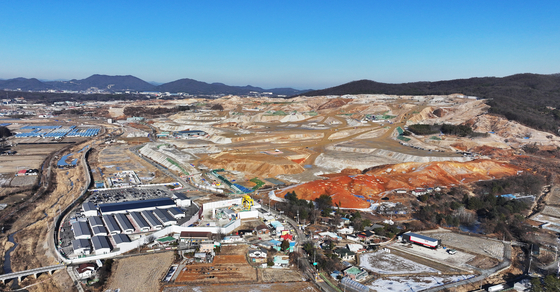![The construction site for a Wonsam chip production plant in Yongin, Gyeonggi, which is part of the semiconductor megacluster in southern Gyeonggi. The government said Monday that a total of 622 trillion won will be invested to build ″the world's largest chip cluster″ by 2042. [YONHAP] The construction site for a Wonsam chip production plant in Yongin, Gyeonggi, which is part of the semiconductor megacluster in southern Gyeonggi. The government said Monday that a total of 622 trillion won will be invested to build ″the world's largest chip cluster″ by 2042. [YONHAP]](https://koreajoongangdaily.joins.com/data/photo/2024/01/16/6e5ea02d-0811-4cfd-82c1-bb1ad55a58c8.jpg)
The construction site for a Wonsam chip production plant in Yongin, Gyeonggi, which is part of the semiconductor megacluster in southern Gyeonggi. The government said Monday that a total of 622 trillion won will be invested to build ″the world's largest chip cluster″ by 2042. [YONHAP]
Korea’s chipmakers will spend a combined 622 trillion won ($471.4 billion) to build “the world’s largest semiconductor cluster” in southern Gyeonggi by 2047.
The initiative — mainly an amalgamation of investment plans previously revealed by Samsung Electronics and SK hynix — was announced by President Yoon Suk Yeol on Monday during a livestreamed policy town hall on the semiconductor industry held at Sungkyunkwan University in Suwon, Gyeonggi. An extension of the tax credit program for chip investments, which was set to expire this year, was also announced.
The government expects the megacluster project to create at least 3 million jobs over the next 20 years and induce production worth 650 trillion won. The ultimate goal is to bring Korea’s self-sufficiency rate in the chip supply chain from its current level of 30 percent to 50 percent by 2030 and the country’s market share in the system-on-chip sector from 3 percent to 10 percent.
Samsung Electronics, specifically, announced that it would spend an additional 120 trillion won on its previously announced project to expand the chip production lines at its Pyeongtaek, Gyeonggi operation from three to six.
“Chips are an integral component of every sector across the board these days,” said Yoon, stressing that “for Korea to become the ‘first mover’ in this scientific revolution led by the semiconductor sector, we need to pour every strategic resource we have into this speed race.”
![President Yoon SuK Yeol speaks during a live-streamed policy townhall on the semiconductor industry held at Sungkyunkwan University in Suwon, Gyeonggi, on Monday. [YONHAP] President Yoon SuK Yeol speaks during a live-streamed policy townhall on the semiconductor industry held at Sungkyunkwan University in Suwon, Gyeonggi, on Monday. [YONHAP]](https://koreajoongangdaily.joins.com/data/photo/2024/01/16/1186419d-247e-40cb-b248-480de1abd8dd.jpg)
President Yoon SuK Yeol speaks during a live-streamed policy townhall on the semiconductor industry held at Sungkyunkwan University in Suwon, Gyeonggi, on Monday. [YONHAP]
The sprawling cluster will measure 21 million square meters (226 million square feet) in size, spanning multiple cities in the southern Gyeoggi region including Pyeongtaek, Hwaseong, Yongin, Icheon, Anseong, Seongnam and Suwon, according to the Ministry of Trade, Industry and Energy.
The cluster, which is already up and running with 19 production facilities and two research labs, will receive three additional production plants and two more research facilities by 2027. The expansion is expected to bring the region’s wafer production capacity to 7.7 million units per month by 2030, which the Korean government explains to be the largest capacity in the world.
A total of 13 manufacturing facilities and three research labs will be added to the site by 2047.
Samsung Electronics will invest a total of 500 trillion won into a 360 trillion won production plant in Namsa, Yongin, which was announced last March. It will also bankroll a 20 trillion won expansion for a research and development (R&D) facility in Giheung, Gyeonggi and another 120 trillion won expansion of its Pyeongtaek facility dedicated to system-on-chips and manufacturing.
Samsung aims to lay the groundwork for its Namsa plant site in 2026 and to have its first production facility operational in 2030.
SK hynix is set to establish a 122 trillion won plant in Wonsam, Yongin, which it will begin constructing in 2025 and aims to have operational in 2027. That plant was first announced in 2019.
The government said that it will speed up and facilitate the establishment of infrastructure for water and power in the region to prevent delays. It allotted 1.3 trillion won to the projects, almost doubling last year's investment. It is also extending its tax credit for semiconductor companies. The previous capital expenditure thresholds of 16 percent for medium-sized companies and 8 percent for large companies have been raised to 25 and 15 percent, respectively.
“Tax credits on semiconductor investments were to expire this year, but the government plans to extend the scheme to continue with the program,” said Yoon.
“Some have been criticizing the tax incentive for ‘subsidizing big companies,’ but that is not the case at all,” the president stressed, adding that incentivizing investments from major chipmakers will ultimately lead to growth across the industry, the creation of new jobs and an increase in country's tax revenue.
Major economies are ramping up support to incentivize semiconductor investments, partly through industry clusters, as the global chip race picks up pace. The U.S. government enacted a 25 percent investment tax credit via the CHIPS and Science Act, and Japan brought TSMC's advanced production facility to Kumamoto with a 476 billion yen ($3.3 billion) subsidy.

Samsung, SK to spend $471 billion on 'world's largest chip cluster'
Korea's chipmakers plan to invest $471.4 billion to create the world's largest semiconductor cluster in southern Gyeonggi by 2047. The project aims to increase chip production and create jobs.
koreajoongangdaily.joins.com

